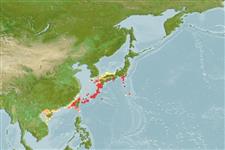>
Eupercaria/misc (Various families in series Eupercaria) >
Labridae (Wrasses) > Corinae
Etymology: Halichoeres: Greek, als, alis = salt + Greek, choiros = pig (Ref. 45335); orientalis: Named in reference to its occurrence in southern Japan and Taiwan (Ref. 31549).
More on author: Randall.
Environment: milieu / climate zone / depth range / distribution range
Ecologia
marinhas associadas(os) a recifes; intervalo de profundidade 2 - 30 m (Ref. 31549). Subtropical
Northwest Pacific: southern Japan and Taiwan.
Tamanho / Peso / Idade
Maturity: Lm ? range ? - ? cm
Max length : 7.6 cm SL macho/indeterminado; (Ref. 31549)
Descrição suscinta
Morfologia | Morfometria
Espinhos dorsais (total): 9; Raios dorsais (total): 12; Espinhos anais 3; Raios anais : 12; Vértebras: 25. Each lateral line scale with 2-4 tubules; without scales on cheek or opercle; without scales basally on dorsal or anal fins; a single pair of stout canines anteriorly in each jaw; a strong canine at corner of mouth; 9th dorsal spine longest, 2.75-3.1 in HL; green with 4 longitudinal salmon pink to orange bands on head, the 2nd and 3rd passing through eye, the 3rd bifurcating on opercle; a small vertically elongate black spot behind eye; upper 3 bands of head continuing as stripes anteriorly on body, and 2 more commencing from beneath pectoral fin, these stripes variously breaking into segments and forming 6 groups of irregular spots dorsally on body, the 2nd group in a dusky blotch; presumed male with this blotch black and containing small irregularly yellow spots; another presumed male phase blackish posteriorly to a vertical through base of 6th dorsal spine.
Ciclo de vida ou comportamento de acasalamento
Maturidade | Reprodução | Desova | Ovos | Fecundidade | Larvas
Distinct pairing during breeding (Ref. 205).
Randall, J.E., 1999. Halichoeres orientalis, a new labrid fish from southern Japan and Taiwan. Zool. Stud. 38(3):295-300. (Ref. 31549)
Status na Lista Vermelha da UICN (Ref. 130435)
Ameaça para os humanos
Harmless
Uso pelos humanos
Mais informação
Idade/TamanhoCrescimentoPeso-comprimentoComprimento-comprimentoFrequências de comprimentoMorfometriaMorfologiaLarvasDinâmica larvalRecrutamentoAbundânciaBRUVS
ReferênciasAquaculturaPerfil para aquaculturaEstirpesGenéticaElectrophoresesHereditariedadeDoençasProcessamentoNutrientsConversão de massa
ColaboradoresFotosStamps, Coins Misc.SonsCiguateraVelocidadeTipo de nataçãoÁrea branquialOtólitosCérebrosVisão
Ferramentas
Relatórios especiais
Baixar XML
Fontes da internet
Estimates based on models
Preferred temperature (Ref.
123201): 21.4 - 27.1, mean 24.9 °C (based on 176 cells).
Índice de diversidade filogenética (Ref.
82804): PD
50 = 0.5000 [Uniqueness, from 0.5 = low to 2.0 = high].
Bayesian length-weight: a=0.00955 (0.00451 - 0.02020), b=3.09 (2.92 - 3.26), in cm total length, based on LWR estimates for this Genus-body shape (Ref.
93245).
Nível Trófico (Ref.
69278): 3.3 ±0.5 se; based on size and trophs of closest relatives
Resiliência (Ref.
120179): Elevada, tempo mínimo de duplicação da população menor que 15 meses (Preliminary K or Fecundity.).
Fishing Vulnerability (Ref.
59153): Low vulnerability (10 of 100).
Nutrients (Ref.
124155): Calcium = 86 [38, 193] mg/100g; Iron = 0.886 [0.457, 1.899] mg/100g; Protein = 19 [16, 21] %; Omega3 = 0.265 [0.138, 0.510] g/100g; Selenium = 10.1 [4.3, 22.6] μg/100g; VitaminA = 113 [30, 544] μg/100g; Zinc = 1.48 [0.87, 2.62] mg/100g (wet weight);
